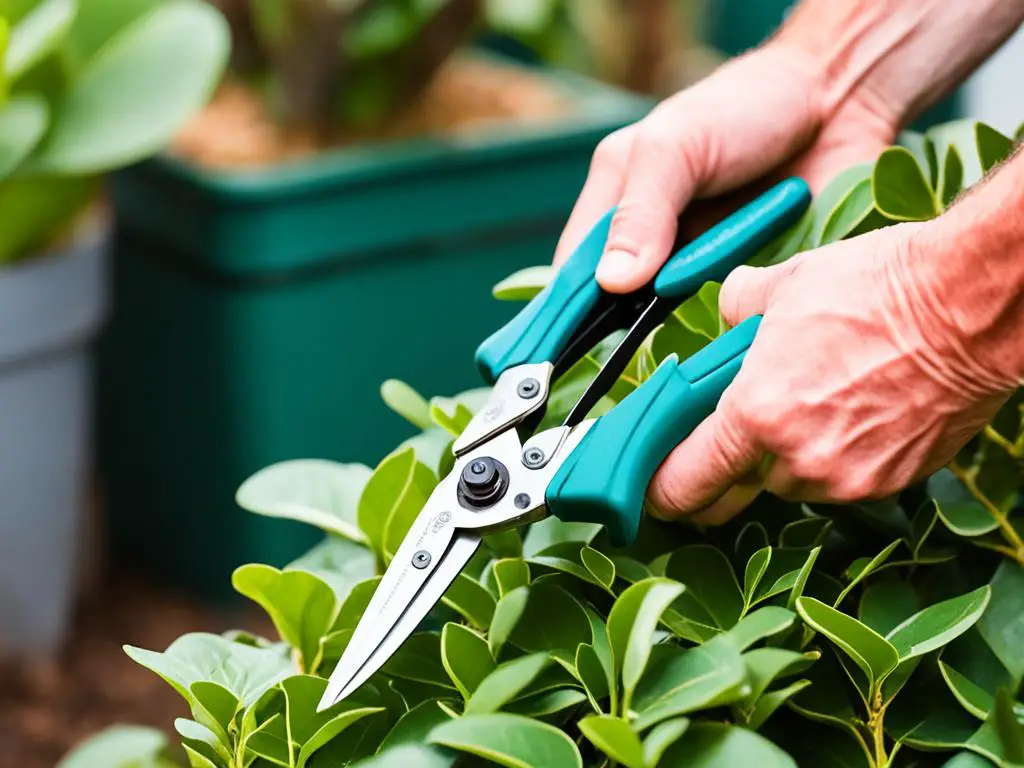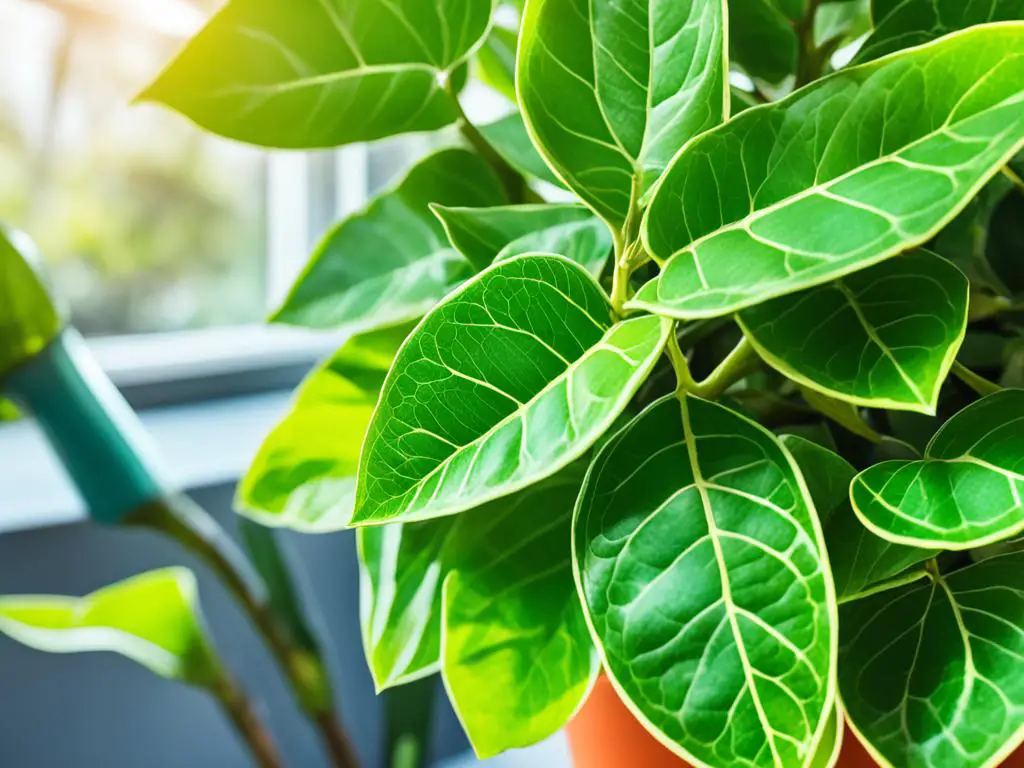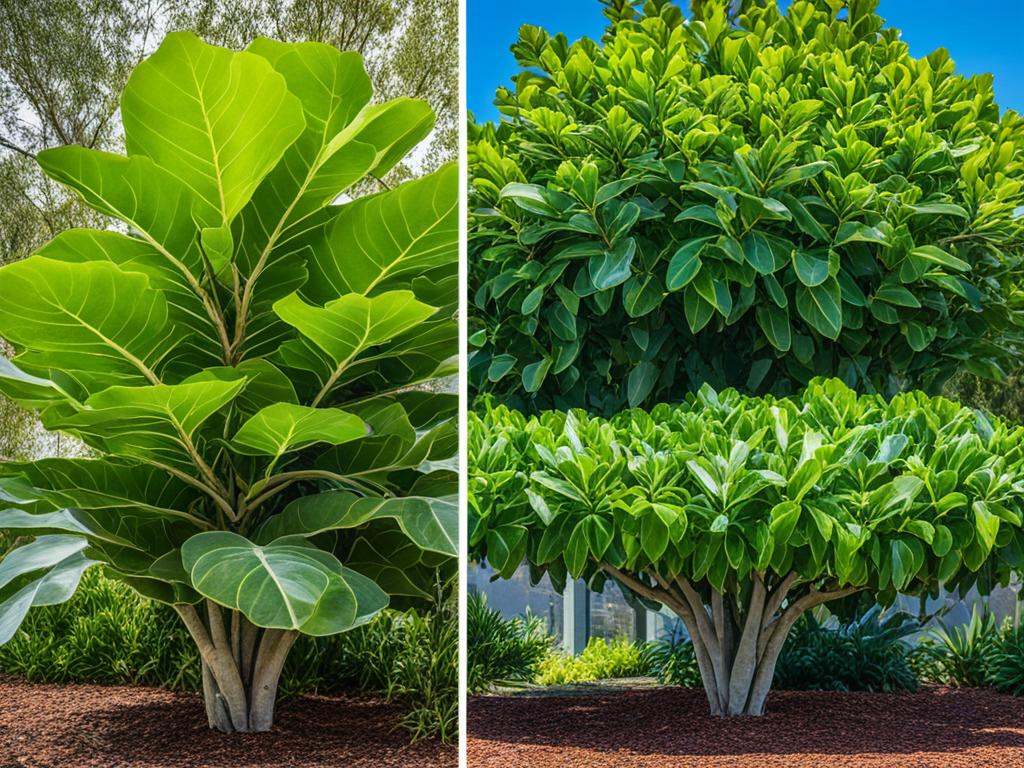The shape of a fiddle leaf fig, also known as Ficus lyrata, can vary between a tree and a bush. Both forms are beautiful, but it’s important to understand the differences and decide which one is best for your space. The choice between a ficus lyrata bush and tree is purely subjective and depends on personal preference and cultivation.
Key Takeaways:
- There are two main forms of ficus lyrata: bush and tree.
- Deciding between a bush or tree shape is a matter of personal preference and cultivation capabilities.
- A bush-shaped fiddle leaf fig is naturally more full and lush, while a tree-shaped fiddle leaf fig has a distinctive lollipop shape.
- Shaping and pruning techniques can be used to achieve both forms, but maintaining the bush shape is easier.
- Both forms require similar care, including bright indirect sunlight, regular watering, and proper fertilization.
Differences Between Ficus Lyrata Bush and Tree
The main difference between a ficus lyrata bush and tree lies in their shape. A bush-shaped fiddle leaf fig is naturally more full and lush, with wide spreading foliage from top to bottom. On the other hand, a tree-shaped fiddle leaf fig boasts a distinctive lollipop shape, featuring a long bare trunk with a cluster of leaves at the top.
Pruning and shaping techniques can be employed to achieve either form, but it is generally easier to maintain the natural bush shape of the fiddle leaf fig.
Ficus Lyrata Bush
The ficus lyrata bush is a beautiful option for those looking to add an abundance of foliage to their space. With its wide spreading leaves, it creates a dense and green canopy, making it a statement piece in any room.
Maintaining the natural bush shape of a ficus lyrata requires regular pruning to encourage branching and promote a fuller appearance.
Ficus Lyrata Tree
A ficus lyrata tree, on the other hand, offers a more structured and striking appearance. Its long bare trunk adds an elegant touch, while the foliage cluster at the top creates a unique focal point.
Shaping a ficus lyrata tree involves techniques such as notching and careful pruning to encourage the growth of branches lower down the trunk and shape the canopy.
Comparison Table: Ficus Lyrata Bush vs. Tree
| Aspect | Ficus Lyrata Bush | Ficus Lyrata Tree |
|---|---|---|
| Shape | Naturally full and lush with wide spreading foliage | Distinctive lollipop shape with a long bare trunk and cluster of leaves at the top |
| Maintenance | Regular pruning to maintain shape and encourage branching | Notching and careful pruning to promote branch growth and shape the canopy |
| Size | More compact and suitable for smaller rooms or limited spaces | Statement piece, adds height and visual interest in larger spaces |
| Care | Similar care requirements, including bright indirect sunlight, consistent watering, and regular fertilizing | Similar care requirements, including bright indirect sunlight, consistent watering, and regular fertilizing |
When deciding between a ficus lyrata bush and tree, consider the shape that best complements your space and the level of maintenance you are willing to undertake. Both forms can bring the beauty of nature indoors, adding a touch of greenery and elegance to your home.
How to Shape a Ficus Lyrata Bush
Shaping a ficus lyrata bush is relatively simple. Regular pruning and shaping techniques can be used to encourage branching and create a bushier appearance. Notching, a technique where small cuts are made on the trunk, can also be used to promote branching. Providing adequate light, water, and nutrients are essential for the healthy growth of a ficus lyrata bush.
Pruning is an effective method to shape a ficus lyrata bush. Start by removing any dead, damaged, or unwanted branches. This will help improve airflow and prevent the spread of diseases. Additionally, pruning can stimulate new growth and make the bush look fuller.
Note: When pruning a ficus lyrata bush, use sharp and clean pruning shears to make precise cuts. Avoid removing more than one-third of the foliage at a time to avoid stressing the plant.
To encourage branching, notching can be done on the trunk of the bush. Make small cuts just below a leaf node, which is where the leaf attaches to the stem. This technique signals the plant to produce new branches at that point, resulting in a bushier appearance over time.
Proper care is essential for the healthy growth of a ficus lyrata bush. Ensure the plant receives bright, indirect sunlight for several hours a day. Water the bush thoroughly when the top inch of soil feels dry, but avoid overwatering to prevent root rot. Fertilize the plant every two to four weeks during the growing season to provide necessary nutrients.

With regular pruning, notching, and proper care, you can shape and maintain a beautiful ficus lyrata bush that adds a touch of nature to your indoor space.
How to Shape a Ficus Lyrata Tree
Shaping a ficus lyrata tree requires more effort and careful pruning. The long bare trunk of a tree-shaped fiddle leaf fig can be encouraged to grow branches lower down by notching and pruning techniques. Notching involves making small cuts on the trunk to promote branch growth. Pruning involves removing unwanted branches and shaping the tree’s canopy. It’s important to use proper techniques and not remove more than 10% of the foliage at a time to avoid shock to the plant.
When shaping a ficus lyrata tree, the goal is to create an appealing lollipop shape with a well-defined canopy. To achieve this, follow these steps:
1. Notching: Begin by making shallow cuts on the trunk using a sharp, sterilized knife or pruning shears. Make the cuts at a 45-degree angle, just above a node where you want a new branch to grow. This technique stimulates the growth of lateral branches, creating a fuller canopy.
2. Pruning: Carefully inspect the tree and identify any unwanted branches or those that are growing in undesirable directions. Use sterile pruning shears to remove these branches, making clean cuts just outside the branch collar. Avoid removing too many branches at once, as this can stress the plant. Aim to remove no more than 10% of the foliage in a single pruning session.
3. Canopy Shaping: Once the tree has developed lateral branches, shape the canopy by selectively pruning to create a more balanced and aesthetically pleasing appearance. Trim any branches that are extending too far outward or crossing over others. Maintain a natural-looking shape by avoiding excessive pruning.
“Pruning a ficus lyrata tree requires precision and patience. Take your time to ensure each cut is made correctly, and regularly step back to assess the tree’s overall shape.”
Remember to regularly inspect your ficus lyrata tree and continue shaping it as necessary. Consistent pruning and shaping will help maintain the desired tree shape and encourage healthy growth.
Care Tips for Ficus Lyrata Bush and Tree
Proper care is crucial for maintaining the health and beauty of both ficus lyrata bushes and trees. By following these care tips, you can ensure that your indoor plants thrive and add an aesthetic touch to your space.
Light Requirements
Ficus lyrata plants require bright, indirect sunlight to thrive. Place your plant near a curtain-filtered window where it can receive several hours of sunlight each day. Avoid placing it in direct sunlight, as this may scorch the leaves.
Watering
Consistent watering is essential for ficus lyrata plants. Keep the soil moist but not soggy to prevent root rot. Water your plant whenever the top inch of soil feels dry. Ensure proper drainage by allowing excess water to drain out of the pot.
Pruning and Shaping
Both ficus lyrata bushes and trees may require pruning to maintain their shape. Bushes may need more frequent pruning to encourage branching and create a fuller appearance. Trees, on the other hand, may require shaping techniques such as notching to promote branch growth and create a lollipop shape.
To prune your ficus lyrata, use clean, sharp pruning shears to remove any dead, damaged, or overgrown branches. Make clean cuts just above a leaf node or bud. Avoid pruning more than 10% of the foliage at a time to avoid stressing the plant.
Fertilizing
During the growing season, fertilize your ficus lyrata every four to six weeks with a balanced houseplant fertilizer. Follow the instructions on the fertilizer packaging for the correct dosage. Fertilizing helps provide the necessary nutrients for leaf production and overall growth.
Care Comparison – Ficus Lyrata Bush vs. Tree
| Ficus Lyrata Bush | Ficus Lyrata Tree | |
|---|---|---|
| Light requirements | Bright, indirect sunlight | Bright, indirect sunlight |
| Watering | Keep soil moist but not soggy | Keep soil moist but not soggy |
| Pruning | More frequent pruning to maintain shape | Shaping techniques may be required to create branching |
| Fertilizing | Regular fertilizing during the growing season | Regular fertilizing during the growing season |
By providing proper care, including adequate light, consistent watering, regular pruning, and fertilizing, you can ensure the healthy growth and longevity of your ficus lyrata bush or tree. Paying attention to their specific needs will result in flourishing plants that enhance the ambiance of your indoor space.

Choosing the Right Shape for Your Space
When deciding between a ficus lyrata bush or tree, it’s important to consider the size and requirements of your space. The choice between the two forms can significantly impact the overall aesthetics of your indoor environment.
The Bush-Shaped Ficus Lyrata
If you have limited space or smaller rooms, a bush-shaped fiddle leaf fig may be the perfect choice for you. With its compact growth habit and lush foliage, it can add a touch of greenery without overwhelming the space. The ficus lyrata bush is a great option for those looking to create a cozy and inviting atmosphere.

The Tree-Shaped Ficus Lyrata
For larger spaces or areas with high ceilings, a tree-shaped fiddle leaf fig can be a stunning focal point. Its tall, lollipop-shaped trunk and cluster of leaves at the top create a sense of height and visual interest. The ficus lyrata tree is an excellent choice for making a bold statement and adding a touch of elegance to your space.
Considerations for Size and Maintenance
Before making a decision, consider the size of your space and the maintenance needs of each form. The bush-shaped ficus lyrata requires less pruning to maintain its shape, making it relatively low maintenance. On the other hand, the tree-shaped ficus lyrata may require more attention to shaping through pruning and notching techniques to achieve the desired structure.
Additionally, think about the visual impact you want to create in your space. The compact nature of the bush-shaped ficus lyrata can create a cozy and intimate atmosphere, while the height and elegance of the tree-shaped ficus lyrata can make a grand statement.
A Comparison of Ficus Lyrata Bush and Tree
| Aspect | Ficus Lyrata Bush | Ficus Lyrata Tree |
|---|---|---|
| Size | Compact | Taller, with a lollipop shape |
| Space Requirement | Smaller rooms or areas with limited space | Larger spaces or areas with high ceilings |
| Maintenance | Less pruning required | More pruning and shaping techniques needed |
| Visual Impact | Cozy and inviting | Grand and elegant |
Consider your available space, maintenance capabilities, and the desired atmosphere when choosing between a ficus lyrata bush or tree. Both forms can bring the beauty of nature indoors and add a touch of green to your home. Whether you opt for the compact bush or the towering tree, the ficus lyrata is sure to be a delightful addition to your indoor plant collection.
Conclusion
Whether you’re deciding between a ficus lyrata bush or tree, providing proper care and maintenance is crucial for your plant’s health and vitality. Both forms offer the beauty of nature and can enhance the aesthetic appeal of your indoor space.
When making a decision, take into account your personal preferences, space limitations, and cultivation capabilities. Consider the size and requirements of your space, as well as the visual impact you desire. A ficus lyrata bush can be a compact option for smaller rooms, while a tree-shaped fiddle leaf fig can be a statement piece in larger spaces, adding height and visual interest.
Remember, regardless of the form you choose, ensure your ficus lyrata receives adequate light, consistent watering, and regular fertilizing during the growing season. Proper pruning and shaping techniques can also be employed to maintain the desired form and promote healthy growth. With the right care and attention, your ficus lyrata will flourish and become a captivating centerpiece in your home.
FAQ
What is the difference between a ficus lyrata bush and tree?
The main difference is the shape. A ficus lyrata bush has wide spreading foliage from top to bottom, while a ficus lyrata tree has a long bare trunk with a cluster of leaves at the top.
How do I shape a ficus lyrata bush?
Regular pruning and shaping techniques, such as notching, can be used to encourage branching and create a bushier appearance.
How do I shape a ficus lyrata tree?
Shaping a ficus lyrata tree requires careful pruning and notching techniques to promote branch growth and shape the canopy.
How do I care for a ficus lyrata bush or tree?
Both forms require bright, indirect sunlight, consistent watering to keep the soil moist but not soggy, and regular fertilizing during the growing season. Proper drainage is important to prevent root rot.
How do I choose between a ficus lyrata bush or tree?
Consider the size and requirements of your space. A bush-shaped fiddle leaf fig is more compact and suitable for smaller rooms, while a tree-shaped fiddle leaf fig adds height and visual interest to larger spaces.



